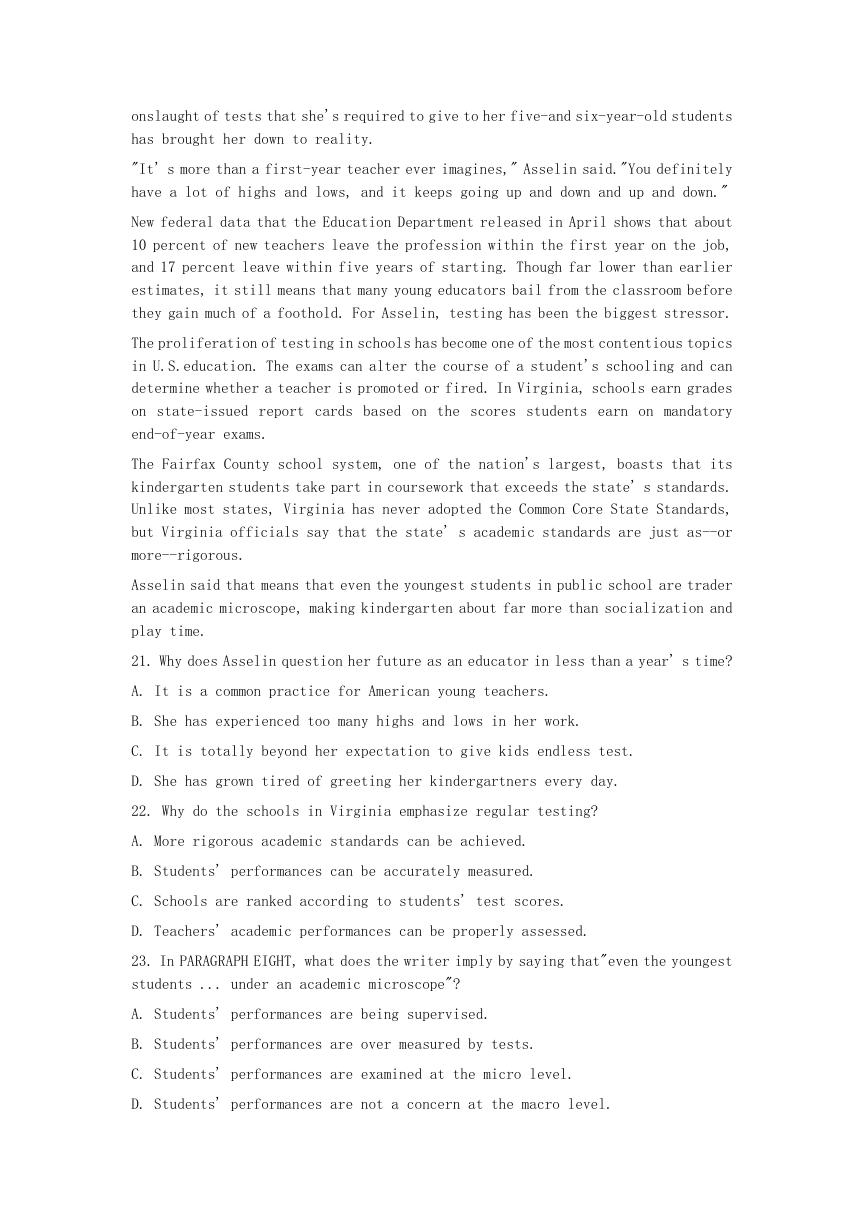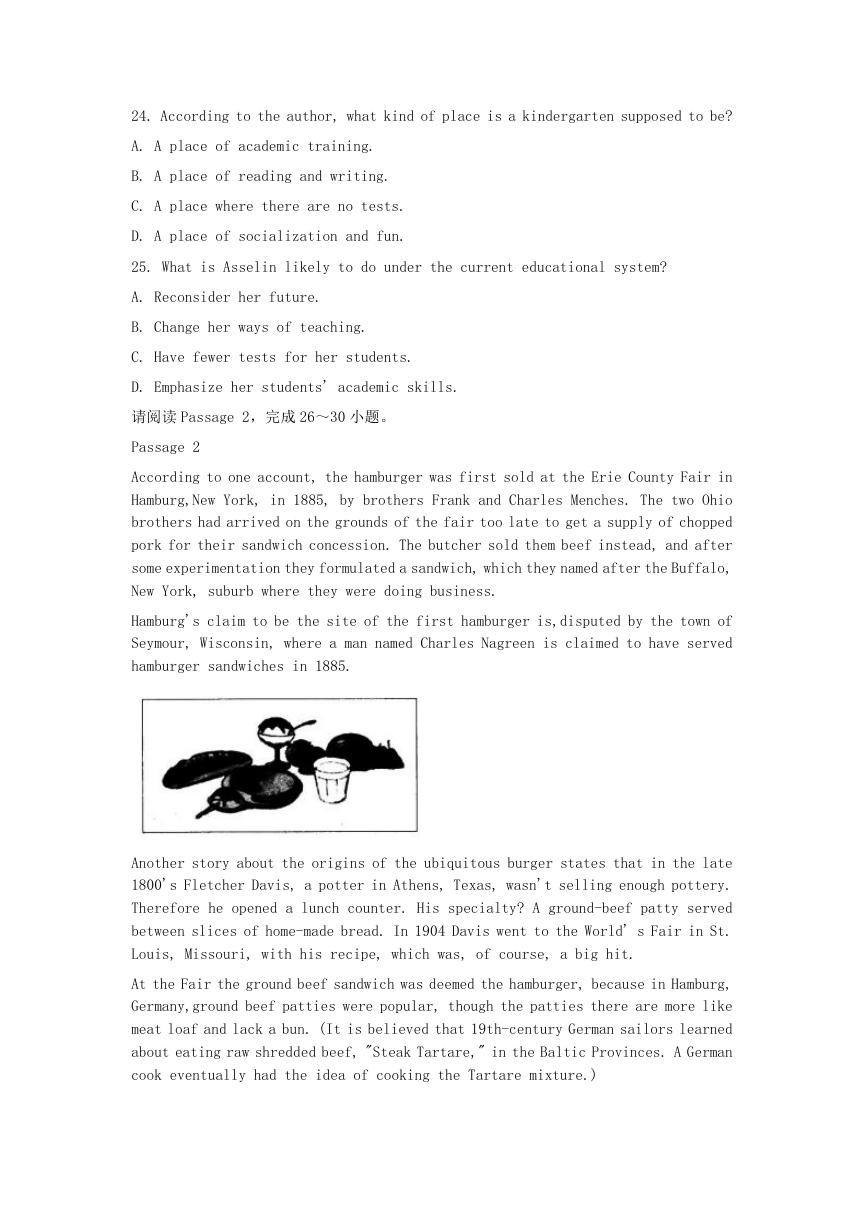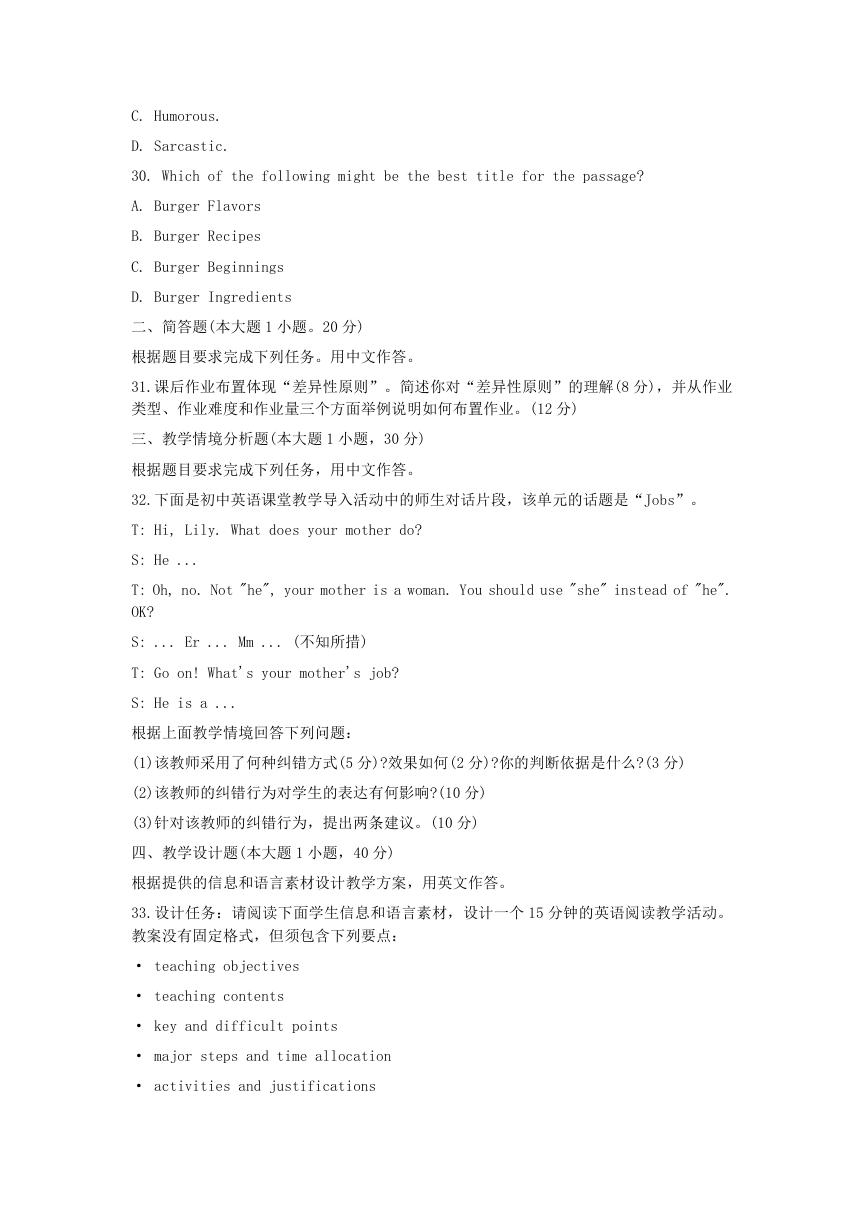2017 上半年贵州教师资格考试初中英语学科知识与教学能
力真题及答案
注意事项:
1.考试时间 120 分钟,满分 150 分。
2.请按规定在答题卡上填涂、作答。在试卷上作答无效,不予评分。
一、单项选择题(本大题共 30 小题。每小题 2 分。共砷分)
在每小题列出的四个备选项中选择一个最佳答案,请用 28 铅笔把答题卡上对应题目的答案
字母按要求涂黑。错选、多选或未选均无分。
1. The main difference between/m/and/n/lies in _________.
A. manner of articulation
B. place of articulation
C. voicing
D. length
2. _________ is the main rhyming pattern in the sentence"Alice's aunt ate apples
and acorns around A ugust. "
A. Reverse rhyme
B. End rhyme
C. Assonance
D. Alliteration
3. Tom is snobbish, always _________the influential people."
A. making out for
B. making up
C. making up to
D. making up for
4. Britain_________ for control of the sea in the 17th century.
A. contended
B. contrived
C. contented
D. confined
5, Which of the following best describes the relation between night and knight?
A. metonymy
B. homonymy
C. antonymy
�
D. hyponymy
6. Of the people who work here, _________ are French and _________ English.
A. half... half
B. the half... the half
C. a half... a half
D. a half... the half
7. You'll find yourself thinking about nothing _________when you're very nervous.
A. wherever
B. whatsoever
C. whenever
D. however
8. Mr. Johnson has a habit of asking questions _________.
A. and then not listen to the answers
B. but then not listen for the answers
C. and then not listening to the answers
D. and then doesn't listen to the answers
9. On hearing the utterance "It's hot here", the listener opened the door. It is
a(n) __________.
A. locutionary act
B. illocutionary act
C. direct speech act
D. perlocutionary act
10. What rhetoric device is used in the sentence "Many hands make light work"?
A. Synecdoche.
B. Simile.
C. Metaphor.
D. Oxymoron.
11. When the teacher attempts to elicit more information from the students by saying
"And ...?","Good. A nything else ?", etc, he/she is playing the role of a__________.
A. prompter
B. participant
C. manager
D. consultant
�
12. For more advanced learners, group work may be more appropriate than pair work
for tasks that are __________.
A. linguistically simple
B. structurally controlled
C. cognitively challenging
D. thematically non-demanding
13. When you focus on "utterance function" and "expected response" by using examples
like"Here you are ", "Thanks", you are probably teaching language at the__________.
A. lexical level
B. sentence level
C. grammatical level
D. discourse level
14. Which of the following tasks fails to encourage active language use?
A. Reciting a text.
B. Bargaining in a shop,
C. Writing an application letter.
D. Reading to get a message.
15. A teacher may encourage students to __________ when they come across new words
in fast reading.
A. take notes
B. ask for help
C. guess meaning from context
D. look up the words in a dictionary
16. Which of the following statements about task design is incorrect?
A. Activities must have clear and attainable objectives.
B. Activities should be confined to the classroom context.
C. Activities must be relevant to students' life experiences.
D. Activities should help develop students' language ability.
17. If someone says "I know the word", he should not only understand its meaning
but also be able to pronounce, spell, and__________ it.
A. explain
B. recognize
C. memorize
D. use
�
18. Teachers could encourage students to use __________ to gather and organize their
ideas for writing.
A. eliciting
B. mind mapping
C. explaining
D. brainstorming
19. When students are asked to go to the local museum, libraries, etc. to find out
information about endangered animals and work out a plan for an exhibition, they
are doing a(n)__________.
A. survey
B. experiment
C. project
D. presentation
20. Which of the following tasks fails to develop students' skill of recognizing
discourse patterns?
A. Analyzing the structure of difficult sentences.
B. Checking the logic of the author' s arguments.
C. Getting the scrambled sentences into a paragraph.
D. Marking out common openers to stories and jokes.
请阅读 Passage 1,完成 21-25 小题。
Passage 1
Kimberley Asselin sits in a rocking chair in front of her 22 kindergartners, a
glistening smile across her face as she greets them for the morning. Even at 9 a.m.,
she is effervescent and charismatic.
Yet behind Asselin's bright expression, her enthusiasm is fading.
Asselin,24, is days away from finishing her first year as a teacher, the career
of her dreams since she was a little girl giving arithmetic lessons on a dry-erase
board to her stuffed bears and dolls.
While she began the school year in Virginia's Fairfax County full of optimism,
Asselin now finds herself, as many young teachers do, questioning her future as
an educator. What changed in the months between August and June? She says that an
�
onslaught of tests that she's required to give to her five-and six-year-old students
has brought her down to reality.
"It' s more than a first-year teacher ever imagines," Asselin said."You definitely
have a lot of highs and lows, and it keeps going up and down and up and down."
New federal data that the Education Department released in April shows that about
10 percent of new teachers leave the profession within the first year on the job,
and 17 percent leave within five years of starting. Though far lower than earlier
estimates, it still means that many young educators bail from the classroom before
they gain much of a foothold. For Asselin, testing has been the biggest stressor.
The proliferation of testing in schools has become one of the most contentious topics
in U.S.education. The exams can alter the course of a student's schooling and can
determine whether a teacher is promoted or fired. In Virginia, schools earn grades
on state-issued report cards based on the scores students earn on mandatory
end-of-year exams.
The Fairfax County school system, one of the nation's largest, boasts that its
kindergarten students take part in coursework that exceeds the state' s standards.
Unlike most states, Virginia has never adopted the Common Core State Standards,
but Virginia officials say that the state' s academic standards are just as--or
more--rigorous.
Asselin said that means that even the youngest students in public school are trader
an academic microscope, making kindergarten about far more than socialization and
play time.
21. Why does Asselin question her future as an educator in less than a year' s time?
A. It is a common practice for American young teachers.
B. She has experienced too many highs and lows in her work.
C. It is totally beyond her expectation to give kids endless test.
D. She has grown tired of greeting her kindergartners every day.
22. Why do the schools in Virginia emphasize regular testing?
A. More rigorous academic standards can be achieved.
B. Students' performances can be accurately measured.
C. Schools are ranked according to students' test scores.
D. Teachers' academic performances can be properly assessed.
23. In PARAGRAPH EIGHT, what does the writer imply by saying that"even the youngest
students ... under an academic microscope"?
A. Students' performances are being supervised.
B. Students' performances are over measured by tests.
C. Students' performances are examined at the micro level.
D. Students' performances are not a concern at the macro level.
�
24. According to the author, what kind of place is a kindergarten supposed to be?
A. A place of academic training.
B. A place of reading and writing.
C. A place where there are no tests.
D. A place of socialization and fun.
25. What is Asselin likely to do under the current educational system?
A. Reconsider her future.
B. Change her ways of teaching.
C. Have fewer tests for her students.
D. Emphasize her students' academic skills.
请阅读 Passage 2,完成 26~30 小题。
Passage 2
According to one account, the hamburger was first sold at the Erie County Fair in
Hamburg,New York, in 1885, by brothers Frank and Charles Menches. The two Ohio
brothers had arrived on the grounds of the fair too late to get a supply of chopped
pork for their sandwich concession. The butcher sold them beef instead, and after
some experimentation they formulated a sandwich, which they named after the Buffalo,
New York, suburb where they were doing business.
Hamburg's claim to be the site of the first hamburger is,disputed by the town of
Seymour, Wisconsin, where a man named Charles Nagreen is claimed to have served
hamburger sandwiches in 1885.
Another story about the origins of the ubiquitous burger states that in the late
1800's Fletcher Davis, a potter in Athens, Texas, wasn't selling enough pottery.
Therefore he opened a lunch counter. His specialty? A ground-beef patty served
between slices of home-made bread. In 1904 Davis went to the World' s Fair in St.
Louis, Missouri, with his recipe, which was, of course, a big hit.
At the Fair the ground beef sandwich was deemed the hamburger, because in Hamburg,
Germany,ground beef patties were popular, though the patties there are more like
meat loaf and lack a bun. (It is believed that 19th-century German sailors learned
about eating raw shredded beef, "Steak Tartare," in the Baltic Provinces. A German
cook eventually had the idea of cooking the Tartare mixture.)
�
Fletcher Davis is also credited with serving fried potato strips at the World's
Fair. A friend in Pads, Texas, had given him the idea, but a reporter thought that
Davis said"Paris, France," and those potatoes are forevermore "French Fries."
Another contender in the "hamburger invention" contest is Louie' s Lunch, a Yale
off-campus eatery. This New Haven, Connecticut, site is said to have first offered
the burger in 1895.
The commercial bun on which hamburgers are now served was created by diner operator
Walter Anderson of Wichita, Kansas, who also invented the modern grill (both events
around 1916) and then established the chain of White Castle hamburger restaurants.
Lionel Clark Sternberger, later proprietor of the Rite Spot steakhouse in Los
Angeles,experimentally tossed a slice of cheese on a hamburger he was cooking at
his father's short-order shop in Pasadena, California, in 1924, thus originating
the cheeseburger.
The word"cheeseburger" was patented by Louis Ballast in 1944. Ballast grilled a
slice of cheese onto burgers at his Denver, Colorado, drive-in.
Well, you know the rest--McDonald's, Burger King, Wendy' s, White Castle, etc.
—burgers everywhere. Some good, some so-so. But certainly an all-American favorite.
A "classic."
26. What are hamburgers most likely to be named after?
A. The recipe for making them.
B. The person who invented them.
C. The place where they were first sold.
D. The restaurant where they are initially served.
27. Which of the following is closest in meaning to the underlined word"ubiquitous"
in PARAGRAPH THREE?
A. Deliciously made.
B. Easily found.
C. Commonly mentioned.
D. Hotly disputed.
28. How did Fletcher Davis make a living before starting to sell his "hamburgers"?
A. He was a sailor in Germany.
B. He sold fried potato strips.
C. He opened a lunch counter.
D. He sold pottery products.
29. Which of the following best describes the author' s tone of writing this article?
A. Factual.
B. Critical.
�
C. Humorous.
D. Sarcastic.
30. Which of the following might be the best title for the passage?
A. Burger Flavors
B. Burger Recipes
C. Burger Beginnings
D. Burger Ingredients
二、简答题(本大题 1 小题。20 分)
根据题目要求完成下列任务。用中文作答。
31.课后作业布置体现“差异性原则”。简述你对“差异性原则”的理解(8 分),并从作业
类型、作业难度和作业量三个方面举例说明如何布置作业。(12 分)
三、教学情境分析题(本大题 1 小题,30 分)
根据题目要求完成下列任务,用中文作答。
32.下面是初中英语课堂教学导入活动中的师生对话片段,该单元的话题是“Jobs”。
T: Hi, Lily. What does your mother do?
S: He ...
T: Oh, no. Not "he", your mother is a woman. You should use "she" instead of "he".
OK?
S: ... Er ... Mm ... (不知所措)
T: Go on! What's your mother's job?
S: He is a ...
根据上面教学情境回答下列问题:
(1)该教师采用了何种纠错方式(5 分)?效果如何(2 分)?你的判断依据是什么?(3 分)
(2)该教师的纠错行为对学生的表达有何影响?(10 分)
(3)针对该教师的纠错行为,提出两条建议。(10 分)
四、教学设计题(本大题 1 小题,40 分)
根据提供的信息和语言素材设计教学方案,用英文作答。
33.设计任务:请阅读下面学生信息和语言素材,设计一个 15 分钟的英语阅读教学活动。
教案没有固定格式,但须包含下列要点:
· teaching objectives
· teaching contents
· key and difficult points
· major steps and time allocation
· activities and justifications
�
















 2023年江西萍乡中考道德与法治真题及答案.doc
2023年江西萍乡中考道德与法治真题及答案.doc 2012年重庆南川中考生物真题及答案.doc
2012年重庆南川中考生物真题及答案.doc 2013年江西师范大学地理学综合及文艺理论基础考研真题.doc
2013年江西师范大学地理学综合及文艺理论基础考研真题.doc 2020年四川甘孜小升初语文真题及答案I卷.doc
2020年四川甘孜小升初语文真题及答案I卷.doc 2020年注册岩土工程师专业基础考试真题及答案.doc
2020年注册岩土工程师专业基础考试真题及答案.doc 2023-2024学年福建省厦门市九年级上学期数学月考试题及答案.doc
2023-2024学年福建省厦门市九年级上学期数学月考试题及答案.doc 2021-2022学年辽宁省沈阳市大东区九年级上学期语文期末试题及答案.doc
2021-2022学年辽宁省沈阳市大东区九年级上学期语文期末试题及答案.doc 2022-2023学年北京东城区初三第一学期物理期末试卷及答案.doc
2022-2023学年北京东城区初三第一学期物理期末试卷及答案.doc 2018上半年江西教师资格初中地理学科知识与教学能力真题及答案.doc
2018上半年江西教师资格初中地理学科知识与教学能力真题及答案.doc 2012年河北国家公务员申论考试真题及答案-省级.doc
2012年河北国家公务员申论考试真题及答案-省级.doc 2020-2021学年江苏省扬州市江都区邵樊片九年级上学期数学第一次质量检测试题及答案.doc
2020-2021学年江苏省扬州市江都区邵樊片九年级上学期数学第一次质量检测试题及答案.doc 2022下半年黑龙江教师资格证中学综合素质真题及答案.doc
2022下半年黑龙江教师资格证中学综合素质真题及答案.doc